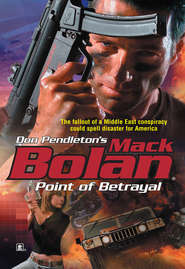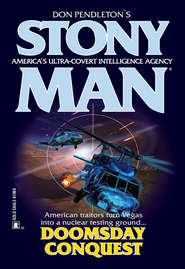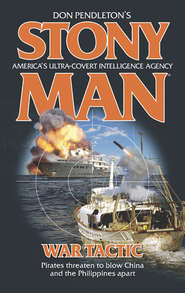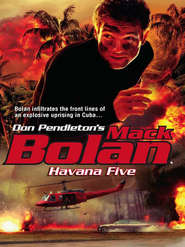По всем вопросам обращайтесь на: info@litportal.ru
(©) 2003-2024.
✖
Threat Factor
Автор
Год написания книги
2019
Настройки чтения
Размер шрифта
Высота строк
Поля
“Let’s go!” he snapped, and steered Waabberi back along the path Bolan had followed as he entered the Bakaara Market, hoping that the shooter was alone. He wasn’t.
Bolan guessed it when he saw three others closing in, instead of shying from the crazy white man with a gun. He knew it when another fired a pistol shot from somewhere on his left flank, missed and struck an old man in the face.
Waabberi ducked and drew a pistol of his own, but held his fire as Bolan said, “Not here!”
The last thing Bolan wanted was a bloodbath to begin his mission in Somalia. He would not initiate a cross fire that endangered innocent civilians, even if the bulk of them were packing heat and long accustomed to surviving in an urban war zone.
“This way!” Bolan urged his contact, weaving through the crowd with shoulders hunched, as more shots sounded from behind them. Someone screamed—a child or woman, from the pitch of it—and then the panic started, as shoppers bolted every which way as they sought to clear the lines of fire.
The first few shots from handguns echoed flatly through the marketplace, but then an automatic rifle joined the chorus. Bolan recognized the stutter of an AK-47 and heard more screams as military rounds struck flesh and bone.
The shooters obviously didn’t care who else went down, as long as they dropped Bolan and/or Waabberi. The Executioner couldn’t pause to verify that he was on some hit list after only two short hours in Somalia, but it strained the notion of coincidence to think the ambush had been sprung by chance, just when Waabberi met him in the market.
He could sort through the details if and when they made it to the car alive and put some space between themselves and the remaining members of the hunting party.
Bolan knew that he could drop at least a couple of them with his liberated SMG, but he resisted the temptation. There was nothing he could do to help the panicked shoppers who were falling all around him, but he would not boost the ever-rising body count.
They’d reached the outskirts of the Bakaara Market, facing onto a street. There would be fewer bystanders out here. His enemies would have a relatively clear shot when they overtook him, and he’d have a chance to deal with them, in turn.
“Across the street,” he urged Waabberi, but they never made it.
As the Executioner stepped off the curb, a car screeched to a stop in front of him, its female driver craning toward the open window on his side.
“Get in,” she snapped, “unless you want to die right here!”
2
Baltimore, Maryland, Three Days Earlier
Meeting in public was a switch. When Hal Brognola met with Bolan to discuss a new assignment, the usual sites were at Stony Man Farm or the resting place of heroes at Arlington National Cemetery. This day, of all places, the meet had been scheduled at Baltimore’s Harborplace and The Gallery Mall.
Brognola had joked about it in their brief telephone conversation, explaining that he had to do some shopping for “the little woman.” Swarovski Crystal, no less, for an upcoming anniversary. Bolan was in the neighborhood, more or less, mopping up the stateside end of a Nigerian heroin pipeline in Newark, and he drove down for the day.
The mall was located on East Pratt Street, in the heart of Baltimore’s posh Inner Bay shopping district. Bolan checked out the sailboats in passing, then focused on the signs that told him where to park his rented car.
Swarovski’s was predictably located in The Gallery, but Bolan was an early bird, by habit and as a condition of survival. He had time to browse through the Pratt Street and Light Street pavilions, admiring the World Trade Center, strolling past the windows of a self-styled psychic’s reading room. Finally, when it was time, he made his way on foot across Pratt Street, into The Gallery.
He trusted that it wouldn’t be a trap—Brognola was too slick for that—but Bolan still remained alert for enemies and noted exits as he passed them, without thinking twice about it. He was ever-conscious of the big Beretta 93-R’s weight beneath his right armpit.
The Gallery’s shops were a mixed bag, though mostly upscale. En route to Swarovski, he passed by Sbarro, Ann Taylor, Trade Secret, Talbot’s, a bank and an entrance to the four-diamond Renaissance Harborplace Hotel, with 620 rooms.
On a professional level, he noted fire alarms and security cameras, checked out the roving security guards whose visible hardware consisted of steel telescoping batons, and wondered if a holdup gang had ever tried the bank. The setup wasn’t perfect—far too many witnesses for comfort—but a team of pros would have the option of escaping over water, through Baltimore Harbor and out into Chesapeake Bay, if they timed it just right.
Most of the shoppers passing by him in the mall were casually dressed, but they still looked like money. There were no homeless souls in evidence, no street urchins except the kind who carefully cut holes in their designer jeans in affectation of a postgrunge style.
The delicate delinquents almost made him smile.
Brognola wasn’t quite as stylish, though he’d spent some decent money on his suit, keeping up with the fast-track bureaucrats in Washington. Still, the fedora planted squarely on the big Fed’s head looked like the same one he’d been wearing when he first met Bolan in Miami, several lifetimes ago.
Brognola’s handshake was the same as always, strong and dry. J. Edgar Hoover had discouraged clammy palms when Brognola was starting as a rookie agent with the FBI, and the big Fed maintained the standard ever since.
“Glad you were in the neighborhood,” he said, as they began to drift along the promenade. “You want some coffee?”
“Might as well,” Bolan replied.
They stopped at Starbucks, ordered coffee black and claimed a table for two in a corner away from the counter, where Bolan sat down with his back to the wall. When they were settled in their chairs, Brognola said, “You’ve been to Somalia. I need you to go back.”
“Okay. What’s going down?”
“Long story short, as you know, Somalia started falling apart back in 1977, when it went to war with Ethiopia. Some kind of border dispute. It seems to happen every day in East Africa. Anyway, the Somali army was decimated and the government’s authority went up in smoke, which sparked a military coup in 1978. A guy named Mohamed Siad Barre held the reins until December 1991, when half a dozen groups of rival insurgents collaborated long enough to kick him out. They replaced him with President Ali Muhammad, but as you might guess, it didn’t work out.”
“The tribal thing,” Bolan stated.
“In spades. Three other would-be leaders pulled out on Muhammad, and the coalition fell apart. Meanwhile, Siad Barre was hanging on with his own army in the south. The chaos and resultant famine prompted UN intervention in December 1992, lasting until the spring of 1995. A lot more people died, including some Americans, with no apparent progress toward resolving any of the country’s problems.”
“Sounds familiar,” Bolan said.
“Depressingly familiar,” Brognola replied. “By 1998 the original country was splintered. You had the self-proclaimed Republic of Somaliland in the northwest, Puntland to the northeast, and Jubaland in the south. None were recognized by us or the UN, and there was still an outfit called the Rahanweyn Resistance Army running wild, shooting at everybody else.”
“There is some kind of government today, though, isn’t there?” Bolan asked.
“You could call it that,” Brognola said. “In 2004 a group of relative moderates founded the Transitional Federal Government, based in Baidoa. Before the ink was dry on their charter, Somalia got spanked with a huge tidal wave from the Indian Ocean, followed by floods that killed 350,000 people in 2006.”
“They can’t catch a break,” Bolan said. “Couldn’t last time I was in Mexico.”
“And Mother Nature’s only part of it,” Brognola told him. “Through it all, a bloody rivalry goes on between the tribes in Jubaland and Puntland, all of them ignoring the transitional government. Come 2006, Islamic fundamentalists declare a new state of their own, called Galmudug, imposing strict Sharia law from the Koran. That basically ignites another civil war between the TFG in Baidoa and something called the Islamic Courts Union. The Muslim militia captured Mogadishu in June 2006, then Ethiopia jumped in six months later, supporting the TGF. Fighting’s in progress as we speak.”
“It’s grim, all right,” Bolan agreed, “but we can’t straighten out a whole country.”
“You’re right,” he replied. “Unfortunately, civil war and scrambled politics are not the only problems in Somalia, right now.”
“Back to the warlords,” Bolan said.
“Exactly right,” Brognola agreed. “We’ve seen it all before, a hundred times. When government breaks down, there’s no Utopia. The savages take over. As it stands right now, the rival gangs in Mogadishu and surrounding areas have staked their claims to three main rackets, when they aren’t killing one another for sport.”
“Those rackets being…?”
“First,” Brognola said, “they went with kidnapping for ransom. It was logical enough, I guess. A spin-off from the civil, where snatching enemy officers may give your side an advantage. Now, though, it’s strictly commercial. The first major target was an economist from Mogadishu University, involved with some kind of UN development program. His kidnappers asked for ten grand, but the UN wouldn’t pay.”
“They killed him?” Bolan asked.
“Nope. Turned him loose, in fact,” Brognola continued, “but started going after fat civilian targets. Anyone with money or a way to get some may be grabbed at any time. You won’t see anyone of any substance traveling through Somalia these days, without a well-armed entourage.”
“Okay, that’s one racket,” Bolan observed.
“The second one is drugs,” Brognola said. “No great surprise, I know, but heroin and coke don’t get much play around Somalia, unless you’re rich and have a sweet connection. The hot ticket is something called khat, a locally grown narcotic plant. Most people chew the leaves to get high, then zone out—and I do mean most people. Current research claims that three out of four adult males in Somalia chew khat every day. It’s highly addictive, and the World Health Organization calls it an epidemic, leading to problems that range from domestic abuse and divorce to street crime. Hit men and guerrillas like it, too. A little bite of courage when they need it most.”
“So, that’s widespread,” Bolan said.











